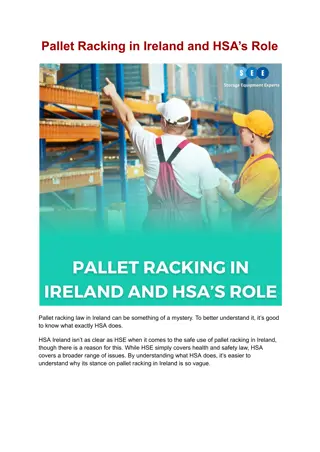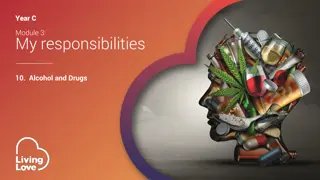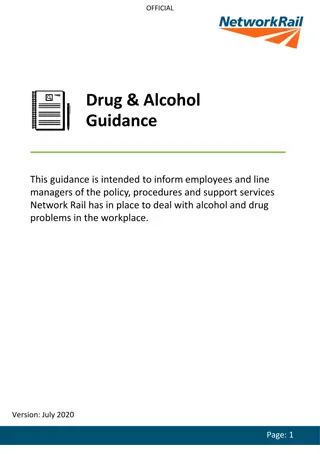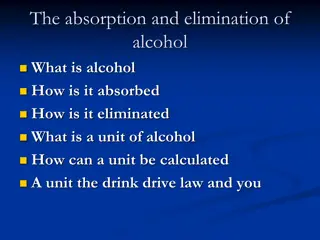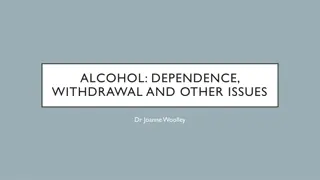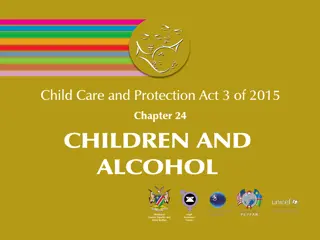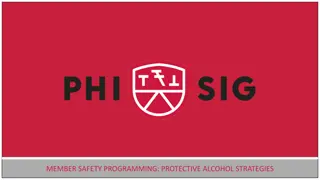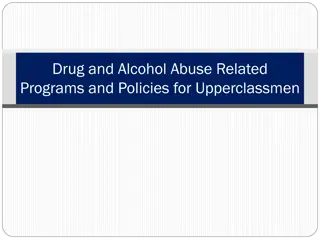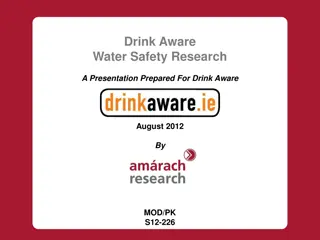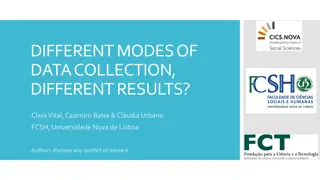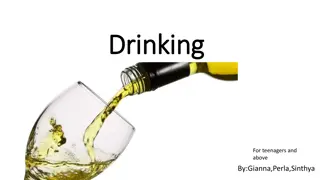Alcohol Consumption Issues in Ireland
In Ireland, alcohol consumption is a major concern with high rates of Alcohol Use Disorder, associated deaths, and societal costs. The culture of heavy drinking, especially among adolescents, is fueled by various risk factors identified in national surveys. However, there are also protective factors that can help mitigate the impact of alcohol misuse, emphasizing the importance of early intervention and support.
Download Presentation

Please find below an Image/Link to download the presentation.
The content on the website is provided AS IS for your information and personal use only. It may not be sold, licensed, or shared on other websites without obtaining consent from the author.If you encounter any issues during the download, it is possible that the publisher has removed the file from their server.
You are allowed to download the files provided on this website for personal or commercial use, subject to the condition that they are used lawfully. All files are the property of their respective owners.
The content on the website is provided AS IS for your information and personal use only. It may not be sold, licensed, or shared on other websites without obtaining consent from the author.
E N D
Presentation Transcript
ALCOHOL 1
ALCOHOL USE IN IRELAND 15% of Irish population have an Alcohol Use Disorder 4 deaths from alcohol per day, 1547 annually >11% of health care budget > 3.7 billion costs to society, likely twice that amount if including harm to others (European Association for the Study of the Liver, 2023) 2
WHY IS ALCOHOL CONSUMED SO HEAVILY IN IRELAND? Multinational alcohol companies Vested interests Ambivalence Many people want to be able to consume alcohol Much activity in Ireland around alcohol/pub (European Association for the Study of the Liver, 2023) 3
ADOLESCENTS AND ALCOHOL Irish Adolescents between the ages of 15 and 16 have the seventh highest rate of drunkenness out of 35 European countries. Alcohol contributes to all the leading causes of death for young people such as: Suicide Road traffic collisions Poisoning Assaults Seven types of cancer Cardiovascular Liver disease 4 National Drug and Alcohol Survey (NDAS)
RISK FACTORS NATIONAL DRUG AND ALCOHOL SURVEY (NDAS) Personal/individual factors Age Sexual orientation Personal characteristics Parental attitudes to drinking Familial factors Parents being drunk Violence in the home Lack of parental supervision Negative attitude to school Social factors Poor grades and attendance at school Skipping school and early school leaving Not engaged in extracurricular activities Lack of perceived risk and strong acceptance of heavy alcohol consumption. Attitudes Availability/accessibility and associated with fun. Marketing/advertising connected to sports, branding/merchandise and social media maintaining perception of fun and low risk. 5
PROTECTIVE FACTORS NATIONAL DRUG AND ALCOHOL SURVEY (NDAS) Personal/individual factors Later initiation to alcohol. Those who begin drinking at aged 15 or younger are four times more likely to develop an alcohol disorder than those who begin at aged 19. Familial factors Adolescents who received alcohol from their parents are 3.5% times more likely to have been drunk in the past 30 days. Adolescents who regularly hang out unsupervised in friends homes are four times more likely to have been drunk in the last 30 days. Adolescents whose parents get drunk are more likely to get drunk and use cannabis themselves. Social factors Adolescents whose friend s get drunk are more likely to drink themselves. Adolescents who have a negative attitude towards school are more likely to drink alcohol, skip school and leave school early. Adolescents who participate in extracurricular activities are less likely to drink. 6 Attitudes Those whose parents do not approve of drunkenness are less likely to drink.
ALCOHOL HARM Alcohol is an addictive substance. 88 people a month die as a direct result of alcohol in Ireland. 1 in 4 deaths of young men aged between 15-39 is due to alcohol. Alcohol is a factor in over a third of all fatal road accidents. Among those who have died by suicide in Ireland, 51%-85% were alcohol dependent. The National Self-Harm Registry Ireland (NSHRI) exposes that alcohol was involved in a third (31%) of all self-harm presentations to the emergency department. 17% of all adolescent self-harm was attributed to heavy drinking. alcoholforum.org 7
WHAT DOES ALCOHOL DO TO THE BODY? High risk of mouth/oral cancer from heavy drinking. Alcohol does not have to be digested by the stomach and goes straight to the blood stream. This is why an empty stomach causes someone to be affected more by alcohol. Food, especially protein, slows absorption but doesn t stop it. Carbonated drinks mixed with alcohol can speed up alcohol absorption. In small amounts, alcohol creates juices in the stomach lining that gives an appetite. Large amounts of alcohol can dull the appetite and cause malnutrition. Excessive alcohol stimulates the flow of gastric juices causing irritation that then causes ulcers. 8
WHAT DOES ALCOHOL DO TO THE BODY CONTINUED Dilates blood vessels. Greater flow of blood to the skin surface. Temporary feeling of warmth. Increased heat loss and rapid body temperature decrease. Drop in blood pressure. When alcohol reaches the brain, it affects functions in the body. As alcohol concentration increases, the body is affected accordingly. This is known as BAC levels (blood, alcohol, concentration). The effects of BAC in stages are as follows: 9
ALCOHOL BAC STAGES BAC .02% Judgment, inhibitions, and emotions begin to be affected and results are increased relaxation and excessive talking. BAC .06% Reaction time is decreased, coordination is affected, but neither may be very obvious. BAC .10% Vision, speech, balance, perception and self-control are affected. BAC .18% Walking and standing are noticeably affected. (walking a straight line, buttoning a coat). BAC .20% Memory is impaired, the brain centre for intelligence, emotions and sensory motor abilities are affected; cannot think clearly and become excited or angered easily. BAC .30% The body is thrown into a complete state of confusion and the signs are: slurred speech, double vision, hearing impairment, difficult or impossible to judge distances, no longer able to walk normally and sudden mood changes. BAC .40% The brain can barely function, and the nervous system is ineffective ; the person is unconscious or almost unconscious; the body may seem frozen or barely able to move, vomiting or uncontrolled urination may occur. 10 BAC .50% A person slips into a coma; breathing, heart action and blood pressure are decreased drastically to a dangerously low point; the brain cannot control body temperature; death can and often does occur.
THE RISKS There is no safe limit of alcohol to drink. 10% of all cancers in men and 3% in women are attributable to alcohol consumption. Even small amounts of overuse of alcohol is attributed to seven types of cancer. No safe amount to drink while pregnant. Drinking alcohol while pregnant can affect the baby. Indirect accidents are likely when intoxicated and many falls, car accidents, acquired brain injuries and other unintended accidents happen as a result of drinking alcohol.11
THE RISKS CONTINUED Alcohol is a diuretic and increases urine formation. More frequent urination, leads to dehydration. Alcohol causes fatty liver and cirrhosis of the liver. Becoming abstinent, reveres liver damage if done early. Cirrhosis of the liver results in scar tissue. 12 The liver tends to function well until it is too late and a transplant is required.
HARM REDUCTION If you are worried about someone having consumed too much alcohol, put them in the recovery position if you can, or on their side and seek medical attention. Avoid using alcohol with other substances. Eat before you drink. Try to stick to one standard drink per hour. Avoid drinking alcohol near bodies of water, roads or other places that could pose a risk. Never drink and drive. Avoid drinking alone. Never leave a drink unattended or pick it up after it has been unattended to reduce the risk of being spiked. 13
IF YOU NEED HELP Check your local services. Services map: https://www.drugsandalcohol.ie/services_map www.drugs.ie cris@mqi.ie tiglin.ie livinglifecounselling.com 14
HARM REDUCTION Try to stay within the recommended limits and spread alcohol use over the week. Your liver can only remove one standard drink per hour. One standard drink = 10mg of pure alcohol Half a pint A single spirit measure A small glass of wine One alcopop Try to have two to three alcohol free days in a week. Smoking and drinking together increases the risk of cancer. Detoxing from alcohol dependence can cause death. If you would like help for your drinking and wish to reduce or become abstinent, seek out your local services. 15
SOURCES/REFERENCES Slide 2 & 3: European Association for the Study of the Liver. (2023) EASL policy statement reducing alcohol harms 2023. Geneva: European Association for the Study of the Liver. Available at https://www.drugsandalcohol.ie/39022/ Slide 4, 5 & 6: Mongan D, Millar S and Galvin B (2021) The 2019 20 Irish National Drug and Alcohol Survey: main findings. Dublin: Health Research Board. Available at https://www.drugsandalcohol.ie/34287/ Slide 7-13: Alcohol Forum Ireland (2022) Alcohol Forum Ireland. Available at https://alcoholforum.org/ [Accessed on 16/11/23] Further reading: Doyle A, Mongan D, Galvin B (2024) Alcohol: availability, affordability, related harm, and policy in Ireland. HRB overview series 13. Dublin: Health Research Board. https://www.drugsandalcohol.ie/40465/ Doyle A, Salome S, Mongan D, Galvin B (2022) Alcohol and other drug use among children and young people in Ireland: prevalence, risk and protective factors, consequences, responses, and policies. Dublin: Health Research Board. https://www.drugsandalcohol.ie/36112/ HRB National Drugs Library. (2024) Factsheet: Alcohol - the Irish situation. Dublin: HRB National Drugs Library. https://www.drugsandalcohol.ie/24954/ 16



